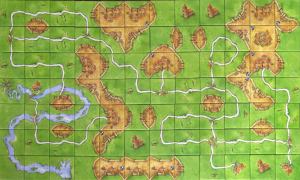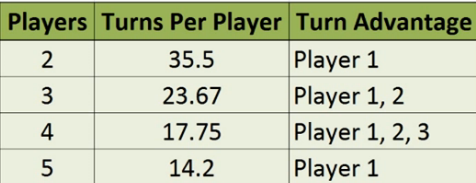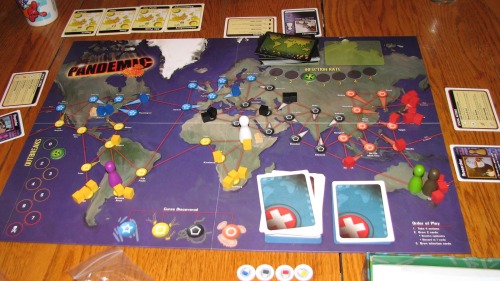Analyzing Carcassonne
Introduction
So this week I will be analyzing the infamous board game Carcassonne or as a senior student named is “Knarkassonne”(roughly translated to drugassonne). I will go through the core system, the system I enjoyed the most, enjoyed least and the most interesting. After this I will try to write about who the board game appeals to the most and a small summary of what I thought of the board game.
Carcassonne
Carcassonne (named after the medieval French city of the same name) is designed by a board game developer named Klaus Jürgen Wrede. The board game includes tiles of different environment that connect as a dynamic puzzle in which you place your followers named Meeples on the environments on the tiles.
There is also a scoreboard in which everyone has a meeple on that goes through a “score road” each time you score.
My group played Carcassonne with the river expansion already included in the box. Each game creates a beautiful map of cloisters, roads, stations, medieval cities, rivers and fields. each tile has either a combination of these environments or just one of them. The game is set up as 8 meeples for each players but one of these eight on the score road board. You then place the river tiles in one pile and the rest(without the starting tile of the original game) in another. The starting player puts the first tile on the table and the rest follow clockwise. All tiles must be connected so:
the rivers connect(they cannot make a u-turn though), a city against a city, roads against roads and fields against fields. You can see an example of a “perfect” connected map (courtesy of http://norvig.com/carcassonne.html).
so a turn involves taking a random(unless it is the first tile and the last river tile) tile and placing is somewhere it fits but after this a player has the option to place their a meeple on an environment of the tile they just placed. Depending on which environment they place is upon they gather up score. The game follows this formula until all tiles are expended.
The goal is to create followers to be knights(meeple on a city), farmers(meeple on a field), bandit(meeple on a road) and priests(meeple on a cloister). The player will gather score at the end of the game but can also get back their meeple if they finish the requirements for each environment. Cloisters have to be surrounded with other tiles, cities have to be finished, roads have to have a station on each end(a city, rest station, cloister or a crossroad) but farms are counted at the very end of the game and need to have cities adjacent to the field. The farmers are connected through fields across the finished board and can be bordered off by placing roads and cities to block them off other fields.
There are also other hurdles like meeples cannot occupy another claimed environment unless they place a tile not connected to the claimed area but then connect it, making the players share its points but if one player has more meeples the other meeples lose the claim and the one with the most meeples gain all the points, rendering the losers meeples useless.
The game demands clever decisions on where you place your meeples and tiles depending on what kind of strategy you are using. On to the systems!
The Good
The dynamic puzzle tiles are in my opinion the greatest achievement this game conquered. You have a massive map of cities, roads, intersections, cloisters and fields, painting a beautiful picture when each game is done.
The 72 tiles fit everywhere and always create a new map on each play through creating both depth in the sense of new opportunities and each strategy a player uses can be countered. The way this system is designed can not only leave room for more dynamics as the massive amount of expansions have showed but the game is immortal. You can easily replace the medieval France theme with a futuristic Dubai, space colonies or any theme you enjoy.
I do have to explain that me saying puzzle does not mean it anything near a puzzle as puzzles are not enjoyed with points, meeples and the strategies Carcassonne offers. This is a game and the system I enjoyed the most are the tiles.
The Bad
The randomness and the system of players. I know we are only allowed one here but I need to make sure I say my five cents here. The random tile given to each player creates missed opportunities and makes sure the player with the most luck wins. With no dice like backgammon it does offer the same amount of help to players like giving the last piece to finish their road/city, extending their road, field or giving the option to contesting an environment. It is way worse to allow more than three players playing cause not only do you lose more turns some players get the advantage shown in this picture.
I feel it creates rift between the players that the dynamic we saw in the game do not balance out later on. While you can potentially play this game in three various ways the turns might make sure you wont get the tile you need. So if you want to counter the system make sure you read upon the tactics of professional players in order to evolve as a player.
The Interesting
There is a rule that allows each player to use something the rule book named diplomacy. This potentially allow each player to give their input to not only disrupts the current players thoughts during their turn, making sure that they wont look in their directions but you can potentially talk your way to win. It has some issues if you are less than four players playing but with a group bigger than three it can be very confusing and for new players this is what they need to watch out for. It demands charm and the inability of other players to succeed but it has so much potential to be used as an offensive force to win.
Who Would Play This
Carcassonne is competitive game with various systems to use as a weapon during the play through so it would bring a side of you that is deceitful, strategic and makes you think in future turns rather than quick reactions. The box recommends players over eight years old with(my gestimation) friends you enjoy intellectually to play with. Elements of both chess and backgammon are used here so I would recommend people that like to create, compete and socially interact with other players.
Core Mechanics
This is a tough one in my opinion. On one hand you can argue that the goal of the game is to gather points and therefore the meeples and the choices of putting them on environments are the core. On the other hand you can argue that the tiles creates opportunity and allows new tactics to evolve making sure be as opportunistic as you can be each time it is your turn. I follow the latter.
The core mechanics of the game in my opinion is the tiles and the dynamic it offers. They are designed very thoughtfully designed to allow a dynamic map each play through, they destroy long term planning as each tactic can be countered and they offer all systems more incentive to be used. It is only destroyed by the fact that the randomness of each tile given.
It can be argued that the random giving of tiles creates a fog of war and during our play-throughs we did create as many stacks of tiles for players to pick from, making the game a bit more interesting.
Summary
Carcassonne challenges your picture memory, social stamina and the ability to read other tactics before they read yours. You have to be vigilant and opportunistic while allowing your plan to be more fluid. While some ways of playing Carcassonne varies depending on who you play with, how much experience they have and how many there are it does have it charm with beautiful art, challenging strategies and the ever so addicting way of gathering points.
The core mechanics help the systems like diplomacy, meeples and the randomness to flourish and with mini-expansions, expansions, spin-offs the re-playability is enormous. Klaus Jürgen Wrede has created a game with little complexity meaning beginners can stand toe to toe with experts.
The limited meeples creates demands caution and the rules of the game are easily understood making this game a new favorite of mine. I would argue that some rules like the meeple booty sharing is a bit off, making someone invest a farmer which can never be returned to the player will lose all of their points just because someone was lucky enough to add more farmers on that field is a bit unjust. I read another review that they proposed a evenly shared booty depending on how many meeples are on that specific field(same with a city/road). It would solve one problem but as I have not played a round with that rule I cannot endorse it but I would not rule it out.
For a game that takes less than an hour to play the play-throughs are unique, enjoyable and will always create a story enough to make sure the game stays on the recently played pile of boardgames.
I give it an eight out of ten(even though it is only an analysis) because of its re-playability and ingenious design.
make sure you look into next week for another analysis.


